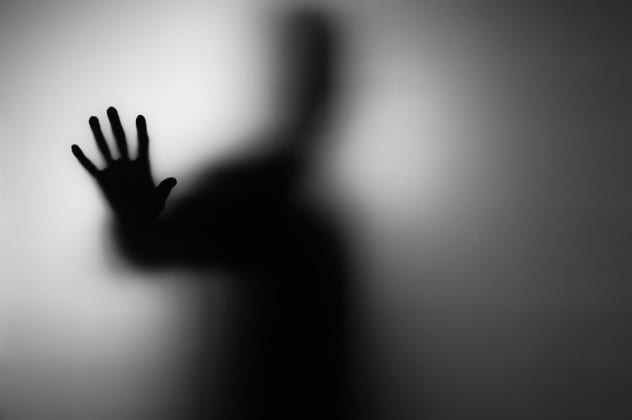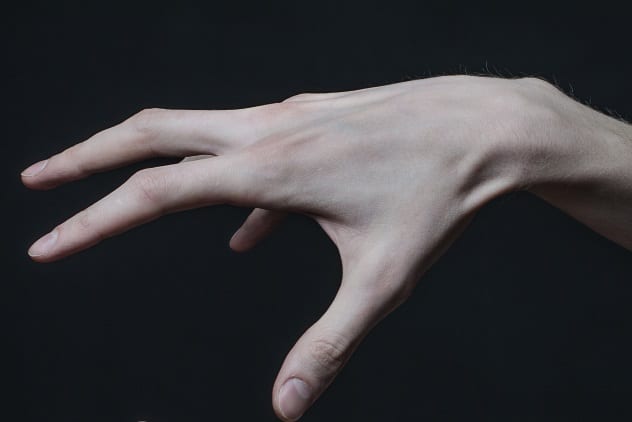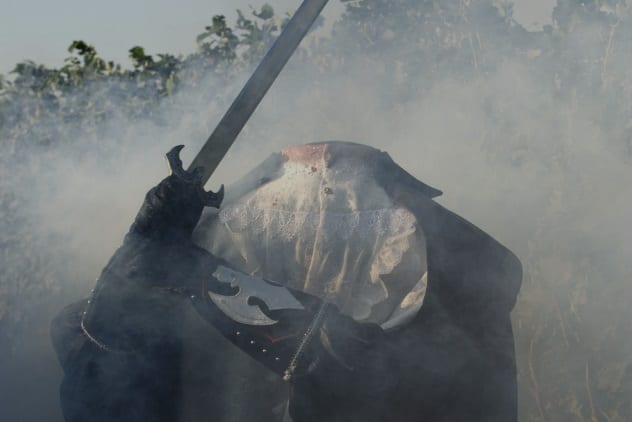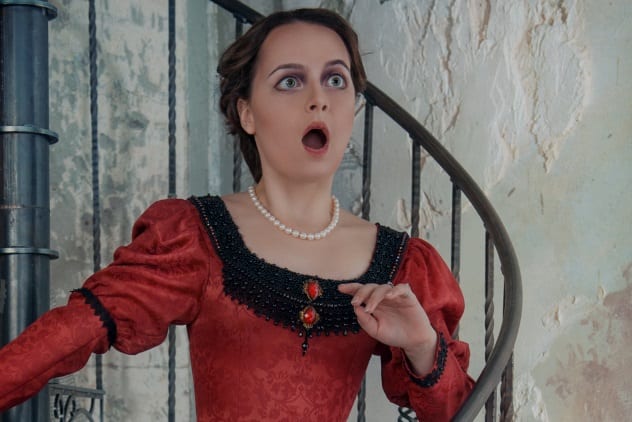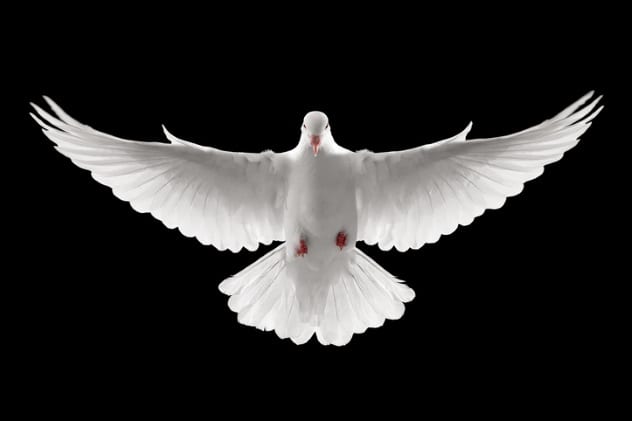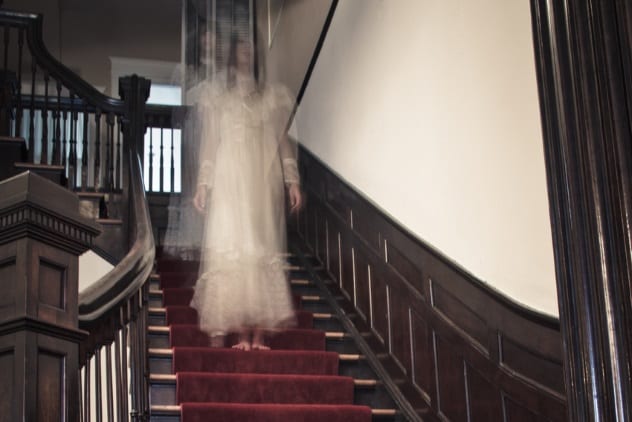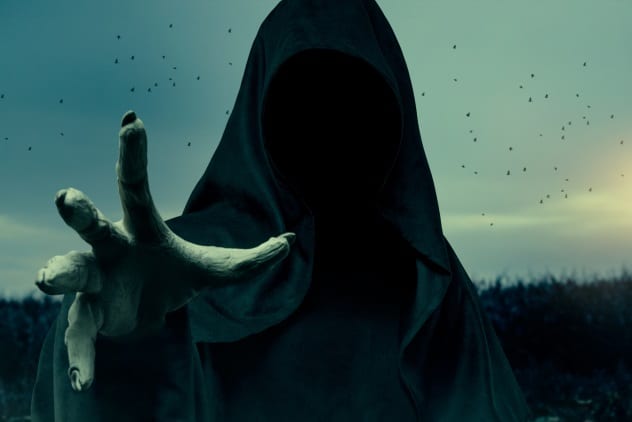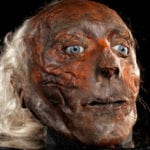However, a small number of people have been lucky enough to have a preternatural warning of upcoming death—assuming, of course, that “lucky” is the right word to describe the situation. These omens of doom are sometimes attached to families and have a history. Others are single occurrences. None are generally welcomed.
10 Eglinton’s Observation
Archibald William Montgomerie, more commonly known as the 13th Earl of Eglinton and 1st Earl of Winton (1812–1861), is said to have been well-known and liked by his fellow countrymen. He’s most remembered for his attempt to revive jousting tournaments as a public spectacle in 1839. Unfortunately, heavy rains chased off the crowd of 10,000 people. When the event was reconvened a day later, most of the crowd didn’t return. Less well-known is a tale that, on October 4, 1861, Lord Eglinton was playing a round of golf on the links of St. Andrews in Fife, Scotland, when he suddenly stopped in the middle of the game. He told his companion, “I can play no more. There is the Bodach Glas. I have seen it for the third time; something fearful is going to befall me.” The Bodach Glas—the “dark gray man”—of Scotland was rumored to haunt certain clans. Eglinton died suddenly that very night of internal bleeding, possibly caused by a stroke, as he was handing a candlestick to a lady who was retiring to her room.[1]
9 Death Gives Hugs
In 1924, Mrs. Bliss Coleman and her husband were living out of a rented room in a house in Oakland, California, and she was in the habit of going back to her room each day when she had a 4:00 PM break at work. One day as Mrs. Coleman was returning at 4:00, she entered the house and saw a woman who was a third-floor tenant talking to the landlady in the hall . . . and there was a 183-centimeter-tall (6′) skeleton standing next to the tenant with a bony arm wrapped around her waist. Neither the third-floor tenant nor the landlady seemed the least bit aware of the third figure in their meeting. Coleman, terrified but knowing she couldn’t explain the weird vision, rushed past the two women and took shelter in her room down the hall. Three weeks later, the third-floor tenant died, leaving her children motherless.[2]
8 Questionable Hospitality
The English Civil War, which lasted from 1642 to 1651, upended the lives of Sir Richard Fanshawe and his wife, Ann, the Lady Fanshawe, in 1649, when they found themselves obligated to quickly vacate their residence in Cork, Ireland, before their neighbors tried to hang them. As they made their way to Spain, they stayed in the homes of a number of friends. This is how they found themselves spending a night at the castle of Lady Honara O’Brien. After dinner and some polite conversation, the Fanshawes excused themselves to their room for the night. At around 1:00 AM, Lady Fanshawe was awoken by a voice coming from the window. She went to it and opened the curtain to discover a woman leaning into the window from outside. The woman wore white and had red hair and a “ghastly complexion”; she cried out the ancient Irish call of mourning, “ochon, ochon, ochon! and then melted away like a cloud. Lady Fanshawe immediately woke her husband to tell him what happened. The following morning, before the Fanshawes could find a way to describe the strange event to Lady O’Brien, the latter told them that she, herself, had not slept well that night, for in a different part of the castle, she had stayed up to care for an ailing cousin of hers who had died at around 2:00 AM. She then expressed hopes that the Fanshawes slept well, for she gave them the best room in the castle . . . but forgot that a spectral woman appeared in that room’s window whenever a family member was dying.[3] The Fanshawes didn’t stay a second night!
7 Hand Off
In 1934, author Elliott O’Donnell made note of the strange experience of a young woman of the MacKenzie family in Scotland. Said young woman had gone upstairs one morning to fetch something from her bedroom and heard something in the room fall as she was leaving. Annoyed, she looked around for source of the noise and found that an old-fashioned silver candlestick had fallen next to her dresser. She walked over to pick it up and stopped as she realized what had knocked the candlestick over to begin with. An arm was protruding from the wall! It was only visible from the elbow down, with very white skin and long fingers and finely finished nails that showed it belonged to a woman, but the rest of the woman wasn’t there. As the young woman stared at this unnatural sight, the limb slowly faded from view. She immediately feared for her mother, as she had been told that a phantom hand was an omen that appeared before a death in her family, and her mother was very ill at that moment. Luckily, her mother fully recovered, but a few days after the arm was seen, a letter arrived to inform them of the untimely death of one of the young woman’s cousins.[4]
6 The Family’s Curse
The problem started with young Ewen MacClaine’s greed. In 1538, Ewen was the son and heir to the chief of the MacClaines of the Lochbuie district, and he didn’t understand why he had to wait to take his father’s wealth. Harsh words were said, and soon, the demands turned into an argument and the argument into a fight. That fight then became a split in the clan, leaving father and son to lead opposing forces into battle against each other. During the heated battle, one of the elder MacLaine’s supporters beheaded Ewen with a single stroke of his weapon . . . but Ewen’s body didn’t fall from his horse. Instead, the corpse lashed out to the left and right, striking nearby clansmen before his horse bolted from the field of battle for home. When the horse arrived back at Ewen’s castle, the servants were horrified to see their master minus his head. The corpse was still sitting up in the saddle, twitching randomly. Convinced that only the Devil himself could be to blame for this matter, the servants decapitated the horse before burying what they had of master Ewen. Ever since that grisly battle, the MacClaine clan of the Lochbuie district has lived in fear of encountering the headless ghost of Ewen MacClaine, still riding his favorite horse and sporting the green cape he wore to the final battle. To see his ghost has but one meaning: The unfortunate witness will soon die.[5]
5 Gwrach Y Rhibyn, The Hag Of The Mist
In Wales, stories are told of the Gwrach y Rhibyn, a profoundly ugly winged hag that comes in the dead of night to flap its wings against the window of a house in which a death will occur, while calling out the name of the doomed party. To say its visits are feared and its deadly warning unwelcome is an understatement, but it’s just a Welsh tale, a curious bit of folklore. Or, at least, that’s what Wirt Sikes thought before he started collecting tales from Welsh farmers for his 1880 book British Goblins. One of the farmers Sikes talked to told of a strange thing that happened to him on November 14, 1878. The farmer was visiting an old friend in Llandaff when he was awoken around midnight by “a frightful screeching and a shaking of [his] window.” Startled, but mostly curious, the farmer ran to the window and threw it open. He saw a figure flying away, which looked over its shoulder back at him, and he knew it was the Gwrach y Rhibyn. The strange hag had disheveled red hair, chalky skin, wings, and teeth like tusks. She wore a long, black gown that trailed behind her on the ground. It appeared as if she had no body below her arms within the billowing material! She screeched again at the window of a house just a little down from where the farmer was, and then she vanished. The farmer kept looking into the darkness and soon saw her again as she entered at the front door of the nearby Cow and Snuffers Inn. He waited for some time but saw and heard nothing more. The following day, the farmer found out that the man who kept the inn had died that night.[6]
4 The Abused Cat
Sometime in the early 1800s, Mrs. Hartnoll’s family were staying in a manor house which was so large that they only occupied one wing of it, keeping the rest locked up most of the time. Part of the unused manor was a hallway that had a sinister feel to it, but Mrs. Hartnoll, in her adventurous youth, decided to investigate it on various occasions. She experienced many strange things in that hallway, but the strangest was the apparent ghost of a mutilated black cat with one eye and paw missing, torn ears, and a slow, curious way of moving. Three times she encountered this strange creature. The first time she saw the cat, it crept out of a doorway and slowly tried to reach her leg to rub against it, instead sinking into the floor. That evening, her brother died. Two years later, she found herself exploring the hallway again when something struck the small of her back. Spinning around, she found the cat again, as bloody and maimed as before and convulsing as if on the edge of its own death. Hartnoll fled the room. Her mother died that night. Four years later, she was in the hall again, but not by her own choice. She had been sent on an errand by her father that required her to pass through the hall, and, presumably, she had not told him anything of her previous experiences there, as she was not supposed to be in that part of the house to begin with. She completed the task as quickly as possible and was on her way out when a shadow appeared in the doorway before her . . . and she once again saw the cat. Her father dropped dead that afternoon. With the loss of his father, Mrs. Hartnoll and her remaining siblings had to leave the house and make their own way in the world. None of them ever returned to the manor.[7]
3 The Oxenhams’ Questionable Omen
In 1641, a pamphlet was published in London entitled A true Relation of an Apparition in the Likeness of a Bird, with a white breast, that appeared hovering over the deathbeds of some of the children of Mr. James Oxenham of Sale Monachorum, Gent, which tells you a lot about the pamphlet! This treatise explained how five relatives of its author, James Oxenham, were each visited by a white-breasted bird that mysteriously appeared and disappeared before their deaths in 1618 and 1635. The story proved popular, and it soon became a well-known legend of a family omen . . . except it wasn’t. The story in the original pamphlet had been invented just to have something to sell. Three of the victims never existed, one died on a different date than mentioned in the pamphlet, and the family never lived in “Sale Monachorum,” as the title states. The witnesses named in the pamphlet also do not appear to have existed, so the whole story was a fraud to begin with, which makes what happened after its publication even stranger. In 1743, over a century after the false pamphlet had been published, William Oxenham was in his chambers with some friends when, for reasons unknown, a white bird flew through. Oxenham, aware of the rumored death omen for his family, quipped that he was not sick enough to die and that “he should cheat the bird!” This surely brought a laugh from those in attendance. Oxenham died two days later after a short, sudden illness.[8]
2 A Castle’s Shame
Dr. Walter Farquhar (1738–1819), who was made a baronet in 1796, had an odd experience in his younger days as a physician before he settled in London in 1769. While visiting the area of Devin, he was called to assist the wife of the steward at Berry Pomeroy Castle. When he arrived, he was shown to an outer apartment and asked to wait there as they prepared the patient to see him. As he waited, a young and well-dressed woman, who he took to be a member of the family, entered the room. He offered polite greetings, but she ignored his presence; she seemed very worried about something and constantly wrung her hands as she crossed the room to the bottom of a stairwell, where she hesitated a moment before ascending the stairs. As she climbed, a sunbeam lit up her face, and Dr. Farquhar was struck by both how beautiful she was and how fantastically sad and hopeless she looked. In a moment, she was gone, and he was called to attend to the ailing wife, whose condition required his immediate and full attention. Farquhar returned the following morning to check on his patient, who was clearly doing much better than the day before. Now that the emergency had passed, Farquhar asked the steward about the young lady he had seen. Farquhar couldn’t have predicted the reaction he got. “My poor wife! My poor wife!,” the steward started to lament. When pressed as to why, the steward explained that the daughter of a previous baron of Berry Pomeroy had given birth to her own father’s child. The unfortunate young woman had then later strangled the child to death in the chamber above the room Farquhar had been waiting in. The young woman Farquhar had seen was a ghost—one that only appeared to presage a death within the castle. She had appeared before the steward’s son drowned, and now the steward was sure that her presence meant his wife was doomed. Despite Farquhar’s assurances that she was recovering and that the steward’s worries were groundless, the steward’s wife died that day at noon.[9]
1 A Friendly Visit
It was a beautiful summer day in 1974, and Dr. Julian Kirchick was enjoying it to the fullest, lying back in a chaise lounge next to his pool as the day was slowly becoming the evening. A cool breeze and the sound of birds comforted him. There was a sudden noise in the bushes near the house, so he stood up to go see what it was. He stopped two steps later. Kirchick was looking at a skeletal figure wearing a monk’s hood and robes, and despite the apparition’s eyes just being hollow, dark holes, he could sense the figure looking back at him. The thin skin was pulled so tight over the face that the structure of the skull was highlighted, and its visible teeth were partly open in what Kirchick felt was meant to be a friendly smile. The strange figure beckoned to Kirchick with a bony hand. Kirchick was frozen in place with fear. Eventually, this strange vision faded. If Kirchick had wondered what the odd visit was about at the time, he felt he knew a few months later, when he was diagnosed with a terminal cancer.[10] Garth Haslam has been digging into strange topics for over 30 years and posts his research on varying anomalies, curiosities, mysteries, and legends at his website Anomalies—the Strange & Unexplained. Check it out at http://anomalyinfo.com.
